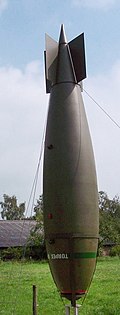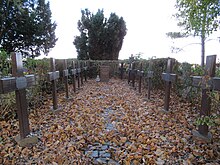Air raids on the Lützkendorf mineral oil plant
The mineral oil works Lützkendorf near Müuellen in Geiseltal in today's Saxony-Anhalt was from May 12, 1944 to May 8th / 9th. April 1945 Target of massive air raids by the Western Allies until it was completely destroyed. In 14 attacks 1715 heavy cast bombers of the 8th Air Force and the Bomber Command of the British Royal Air Force about the work and its environment about 23,800 bombs (5,400 tons). The destruction was completed five days before the occupation by US troops , also using bunker-breaking mine bombs ( tallboys ). The villages and settlements in the Geiseltal and its surroundings were also badly hit.
The work
The Lützkendorf mineral oil plant (from 1938 Lützkendorf was a district of Krumpa ) of Wintershall AG was built between 1936 and 1944 at a cost of 112 million Reichsmarks. It was one of the largest refineries in Germany for the production of fuels and lubricants . It produced synthetic gasoline , lubricating oil and hydrogenation gasoline , also specifically military-grade products. Around 5,000 workers and employees were employed in the company in April 1944. These included numerous foreigners, especially Dutch , Italians and Poles . From March 1944 to the end of the war, inmates of a subcamp of the Buchenwald concentration camp did forced labor in the facility , especially after the air raids on the plant.
Like the entire Central German chemical region, the plant was defended by a strong concentration of heavy flak batteries.
The individual air strikes
This compilation is mainly based on Matthias Koch and the work of Heinz Rehmann "Bombs on the chemical region". The information from both publications on the number of attacks (not all listed by Rehmann), the number of aircraft involved and the tonnage of bombs dropped in individual attacks do not always match (but the total tonnage is the same).
Both the 8th Air Force and the participating RAF units were stationed in southern England. The eleven US air strikes were carried out during the daytime and all three subsequent British attacks at night. The USAAF deployed their four-engine B-17 “Flying Fortress” and B-24 “Liberator” bombers, the RAF their four-engine Avro Lancaster - led by Mosquito high-speed bombers. The escort was carried out by numerous long-range fighter planes that also operated as low-flying aircraft . There were bombs of all calibers to the British bunker-busting Tallboys used. The flight altitude of the machines was around 3,500 to 7,000 meters.
The USAAF attacks



On May 12, 1944, the Anglo-American “oil offensive” against the German Reich began with massive air raids . Lützkendorf was there on the opening day.
- May 12, 1944: 89 “Flying Fortresses” B-17 dropped 2,941 explosive bombs from 13:57 to 14:01 when visibility was (good) and guided by Pathfinder machines over the plant and its surroundings, equivalent to 172 tons. A full alarm had been given ten minutes earlier. The bulk of the bombs landed in the western part of the plant, but a large part also in the neighboring town of Krumpa , the Wintershall settlement was particularly hard hit. The Cecilie briquette factory was also involved in the attack. The material damage (16 million Reichsmarks ) and the loss of people were devastating: 159 deaths, 81 of them in the factory and 35 in the village of Krumpa, including women and children. Over 100 wounded had to be cared for. In the opinion of the plant management, the element of surprise played a major role. Some of the workforce fled to the area around the plant.
Air raid tunnels and shelters built into existing buildings since 1942 had already existed, bomb-proof bunkers in the plant were now being built at great expense: high-rise bunkers and seven "Salzgitter" series 134a air raid bunkers . There were also numerous one-man bunkers for maintenance personnel. The following attacks did not cause such high losses of people as on May 12th.
The funeral service took place on May 18th with the participation of the surrounding villages. The dead were buried in a second cemetery in Krumpa, which was hastily built for this purpose ("Heroes' Cemetery"), which still exists today. Some of the tombstones have been preserved. The flak belt around the chemical industry was considerably strengthened after the experience of May 12, 1944.
- May 28, 1944 (Pentecost Sunday): 64 B-24 “Liberator” dropped 1,620 explosive bombs (151 tons) on sight from 3:01 pm to 3:04 pm. Most of the bombs hit Neumark, east of the plant . The large "Europa-Tank" (building 301) was hit in the plant and burned out. The material damage was estimated at 9 million RM. Officially there were only two deaths, but contemporary witnesses reported more victims: in Kämmeritz and Neumark.
The successful Allied bombing of the German chemical industry from May 1944 led to the petroleum security plan of Edmund Geilenberg . For Lützkendorf, too, it brought with it the mass deployment of (initially 3,400) foreign and forced laborers , Italian military internees , prisoners of war and concentration camp inmates : for clean-up and reconstruction work (Rehmann p. 30/32)
- July 7, 1944: 104 B-24s and 33 B-17s dropped 2,987 bombs (297 tons) between 9:23 and 10:12 a.m.: Damage 12 million RM. 63 bombs fell in the Mücheln miners' settlement of Neubiendorf : twelve houses were destroyed or badly damaged, 76 medium to light. The settlement in Krumpa was hit again, including a camp for “foreign workers”.
- July 20, 1944: 53 B-17s dropped 538 bombs (132 tons) from 11:21 a.m. to 11:25 a.m. under Pathfinder guidance. There are hardly any documents about the damage; only indirectly one can infer the victims among Polish and Soviet prisoners.
- September 11, 1944: 85 (96) B-17s dropped 1,042 bombs (261 tons) from 11:56 a.m. to 12:11 p.m., on sight, Pathfinder. Serious damage was done in the southern part of Müelte. Even larger concrete bunkers are now being built centrally in the plant for the mass reception of people.
- September 13, 1944: 69 (98) B-17s dropped 721 bombs (194 tons) from 11:16 to 11:36 a.m., on sight. 5 million RM damage. The carpet of bombs hit especially the western part of the target area and the Krumpa in front of it. There was "enormous damage" to residential buildings, especially housing developments.
- October 7, 1944: 88 B-17s dropped 836 bombs (209 tons) between 12:20 and 12:33 p.m. on sight.
- October 25, 1944: 2 B-17s dropped 24 bombs (6 tons) using H2X radar.
- November 30, 1944: 148 B-17s dropped 2,894 bombs (362 tons) on sight between 12:34 and 1:29 p.m.
- December 6, 1944: 13 B-17s dropped 200 bombs (25 tons) at 12:16 p.m. under H2X command.
- February 9, 1945: 199 (233) B-17s dropped 1,966 bombs (492 tons) from 12:57 to 13:05 in one of the heaviest attacks to date. The property damage was estimated by the Wintershall plant management at 12 million RM. Residential buildings in Krumpa and the Mücheln districts of Möckerling and Neubiendorf were hit again . The Cecilie mine and the “Deutsche Grube” (belonging to the Leuna works) were also badly affected.
In total, the US Air Force dropped 15,769 bombs (2,302 tons) on the plant and its industrial and residential surroundings in eleven attacks from 947 aircraft.
The RAF attacks
The British bomber units were navigated using Pathfinder and "Target Indicators".
- March 14, 1945: 235 Avro Lancaster of the 5th Bomber Group , led by ten Mosquito target markers, threw from 9:33 pm to 10:15 pm from a height of 3,500 to 5,000 meters above the Lützkendorf plant (especially the eastern part) and its surroundings 2,886 bombs (1,003 tons) dropped. These included 206 mine bombs, 4,000 lb HC bombs ( blockbusters ) and many time fuse bombs. The factory was temporarily idle after the attack. Shortly after the bombs were thrown, “21 dead, numerous wounded and many more buried” were recorded. The places in the area were also badly damaged, especially Neumark, Benndorf , Kämmeritz, Geiselröhlitz, Kulkwitz and Stöbnitz . Lignite mining operations were also badly affected, including by mine bombs. The “Ostfeld” mining operation recorded a “dug up mine field” after 500 to 600 explosive bombs and mines were dropped. In the factory colony there were 13 deaths in severe building damage. A community camp and a prison camp were also destroyed. 18 Lancaster fell victim to the German air defense.
- April 4, 1945: 258 Lancasters and 14 Mosquitos of the 1st Bomber Group dropped 2,656 bombs (1,076 tons) over the plant and its surroundings at night. These included 228 4,000 lb HC mine bombs. A large part of the bombs fell on fields between Krumpa and Schortau. It is said to have been errors in target marking by mosquitos flying ahead. The attack could "not shut down" the plant, so another one was planned. Six Lancasters were shot down.
26 German and Italian soldiers were killed by bombs in the anti-aircraft gun "Großkampfbatterie" Schortau . They were buried in the Schortau cemetery. The grave complex has been preserved.
- April 8, 1945: 231 Lancasters and 20 mosquitos of the 5th Bomber Group dropped 2,481 bombs (1,033 tons) at night. Among them were 177 pieces of mine bombs of the type 4,000 lb HC ("Blockbuster") as well as 17 bunker-breaking tallboys ("Big Boys") 12,000 lb DT, also known as "Earthquake Bombs". The latter had a timer setting of 30 to 60 minutes after the impact, which was catastrophic for the salvage work that was then in progress. This attack brought the "final" for the Lützkendorf plant. Six Lancasters were lost. One of them was shot down after her tallboy was dropped. Only one crew member, the sniper could be before the crash at Chapel village near Weimar with the parachute rescue.
During the three night raids, the RAF dropped 8,022 bombs (3,112 tons) on the plant and its surroundings from 768 aircraft. She lost to the German Flak 30 four-engined Avro Lancaster bombers (i.e. about 210 men flying personnel who were killed or captured).
Final consideration
US Air Forces and RAF taken together: in 14 attacks and the use of 1,715 aircraft, 23,791 bombs, equivalent to 5,414 tons, were dropped on the Lützkendorf plant and its industrial and residential area.
After April 8, 1945, the plant presented a "picture of horrific destruction" (Wintershall report). By March 1945, the repair work (at times with 8,000 emergency workers) and the resumption of production had still been partially successful despite the devastating attacks.
A total of 200 deaths were to be lamented in the plant and its surroundings (Rehmann, p. 32). If one adds up the individual reports, however, then significantly more victims can be assumed - even when considering the force of the attacks and the bomb load.
literature
- Roger A. Freeman: Mighty Eighth War Diary . London. New York. Sydney 1981. ISBN 0-7106-0038-0 .
- Olaf Groehler : bombing war against Germany . Akademie-Verlag, Berlin 1990. ISBN 3-05-000612-9 .
- Heinz Rehmann: The bomb attacks on the Lützkendorf mineral oil plant of Wintershall AG in bombs on the chemical region - The Anglo-American bomb attacks during the Second World War on targets in the Merseburg area and the German defensive measures . Heinz Rehmann, Reinhart AO Roesch. Friends of the Chemical Industry Association V. “, Merseburg (ed.). Buna Sow Leuna Olifinverbund, Merseburg 2002. pp. 27-33.
Individual evidence
Web links
- Matthias Koch: The Geiseltal . Target of attack Geiseltal. Attacks 1940–1945. [2]


